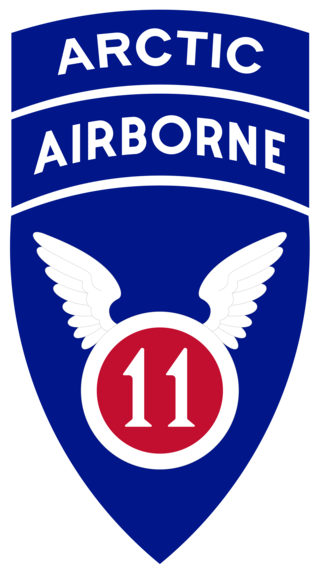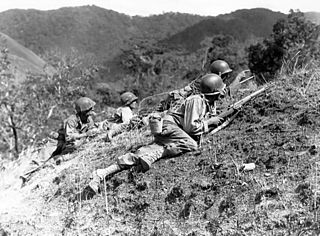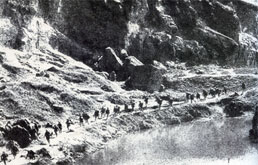
The 11th Airborne Division is a United States Army airborne formation based in Alaska.

The Burma campaign was a series of battles fought in the British colony of Burma. It was part of the South-East Asian theatre of World War II and primarily involved forces of the Allies against the invading forces of the Empire of Japan. Imperial Japan was supported by the Thai Phayap Army, as well as two collaborationist independence movements and armies. The first of these was the Burma Independence Army, which spearheaded the initial attacks against the country. The Indian National Army, led by Subhas C. Bose of the Free India movement, also collaborated with Imperial Japan, especially during Operation U-Go in 1944. Nominally independent puppet states were established in the conquered areas and some territories were annexed by Thailand. In 1942 and 1943, the international Allied force in British India launched several failed offensives to retake lost territories. Fighting intensified in 1944, and British Empire forces peaked at around 1 million land and air forces. These forces were drawn primarily from British India, with British Army forces, 100,000 East and West African colonial troops, and smaller numbers of land and air forces from several other Dominions and Colonies. These additional forces allowed the Allied recapture of Burma in 1945.
The Battle of Nanchang was a military campaign fought around Nanchang, Jiangxi between the Chinese National Revolutionary Army and the Japanese Imperial Japanese Army in the Second Sino-Japanese War. It was the first major conflict to occur following the Battle of Wuhan.

The Battle of Luzon was a land battle of the Pacific Theater of Operations of World War II by the Allied forces of the U.S., its colony the Philippines, and allies against forces of the Empire of Japan. The battle resulted in a U.S. and Filipino victory. The Allies had taken control of all strategically and economically important locations of Luzon by March 1945, although pockets of Japanese resistance held out in the mountains until the unconditional surrender of Japan. While not the highest in U.S. casualties, it is the highest net casualty battle U.S. forces fought in World War II, with 192,000 to 217,000 Japanese combatants dead, 8,000 American combatants killed, and over 150,000 Filipinos, overwhelmingly civilians who were murdered by Japanese forces, mainly during the Manila massacre of February 1945.

The Battle of Wuhan, popularly known to the Chinese as the Defence of Wuhan, and to the Japanese as the Capture of Wuhan, was a large-scale battle of the Second Sino-Japanese War. Engagements took place across vast areas of Anhui, Henan, Jiangxi, Zhejiang, and Hubei provinces over a period of four and a half months. It was the longest, the largest, and arguably the most significant battle in the early stages of the Second Sino-Japanese War. More than one million National Revolutionary Army troops from the Fifth and Ninth War Zone were put under the direct command of Chiang Kai-shek, defending Wuhan from the Central China Area Army of the Imperial Japanese Army led by Shunroku Hata. Chinese forces were also supported by the Soviet Volunteer Group, a group of volunteer pilots from Soviet Air Forces.
The Battle of West Hunan, also known as the Battle of Xuefeng Mountains and the Zhijiang Campaign, was the Japanese invasion of west Hunan and the subsequent Allied counterattack that occurred between 6 April and 7 June 1945, during the last months of the Second Sino-Japanese War. Japanese strategic aims for this campaign were to seize Chinese airfields and secure railroads in West Hunan, and to achieve a decisive victory that their depleted land forces needed.

The Battle of Changde was a major engagement in the Second Sino-Japanese War in and around the Chinese city of Changde (Changteh) in the province of Hunan. During the battle, the Imperial Japanese Army extensively used chemical weapons.

The Battle of Shanggao, also called Operation Kinkō, was one of the 22 major engagements between the National Revolutionary Army and Imperial Japanese Army during the Second Sino-Japanese War.

The Battle of Xinkou was a decisive engagement of the Taiyuan Campaign, the second of the 22 major engagements between the National Revolutionary Army and Imperial Japanese Army during the Second Sino-Japanese War.

The Battle of Königsberg, also known as the Königsberg offensive, was one of the last operations of the East Prussian offensive during World War II. In four days of urban warfare, Soviet forces of the 1st Baltic Front and the 3rd Belorussian Front captured the city of Königsberg, present day Kaliningrad, Russia. The siege started in late January 1945 when the Soviets initially surrounded the city. Heavy fighting took place for control of overland connection between Königsberg and the port of Pillau, however by March 1945 Königsberg was hundreds of kilometres behind the main front line in the eastern front. The battle ended when the German garrison surrendered to the Soviets on 9 April after a three-day assault made their position untenable.

The Manchukuo Imperial Army was the ground force of the military of the Manchukuo, a puppet state established by Imperial Japan in Manchuria, a region of northeastern China. The force was primarily used for fighting against Communist and Nationalist guerrillas in Manchukuo but also took part in battle against the Soviet Red Army on several occasions. It initially consisted of former National Revolutionary Army troops of the "Young Marshal" Zhang Xueliang who were recruited after the Japanese invasion of Manchuria en masse, but eventually expanded to include new volunteers and conscripts. The Imperial Army increased in size from about 111,000 troops in 1933 to an estimated strength of between 170,000 and 220,000 soldiers at its peak in 1945, being composed of Han Chinese, Manchus, Mongols, Koreans, Japanese, and White Russians. Throughout its existence the majority of its troops were considered to be mostly unreliable by their Japanese officers and advisers, due to poor training and low morale.

The Pacification of Manchukuo was a Japanese counterinsurgency campaign to suppress any armed resistance to the newly established puppet state of Manchukuo from various anti-Japanese volunteer armies in occupied Manchuria and later the Communist Northeast Anti-Japanese United Army. The operations were carried out by the Imperial Japanese Kwantung Army and the collaborationist forces of the Manchukuo government from March 1932 until 1942, and resulted in a Japanese victory.

The Battle of Wanjialing, known in Chinese text as the Victory of Wanjialing, refers to the Chinese Army's successful engagement during the Wuhan theatre of the Second Sino-Japanese War against the Japanese 101st, 106th, 9th and 27th divisions around the Wanjialing region in 1938. The two and a half month battle resulted in heavy losses of the Japanese 101st and 106th Divisions.
Zhengtai Campaign was a series of battles fought between the nationalists and the communists during Chinese Civil War in the post World War II era, and resulted in the communist victory.
The Battle of Yongjiazhen (雍家镇战斗) was fought during the aftermath of World War II in the Yongjiazhen (雍家镇) region of central Anhui, China between Communist forces and Kuomintang forces who had allied with the Japanese. The battle was part of the Chinese Civil War, resulting in a victory for the People's Liberation Army.

The 21st Infantry Regiment ("Gimlet") Is a United States Army infantry regiment. The 1st Battalion currently exists as part of 2nd Infantry Brigade Combat Team, 25th Infantry Division and the 3rd Battalion of the 1st Infantry Brigade Combat Team 11th Airborne Division. The regiment fought in World War II, the Korean War and the Vietnam War, as well as Operation Iraqi Freedom. Task Force Smith, the first American unit to see action in the Korean War, was derived from the regiment's 1st Battalion.

Australia entered the Korean War on 28 September 1950, following the invasion of South Korea by North Korea. The war's origins began after Japan's defeat in World War II, which heralded the end to 35 years of Japanese occupation of the Korean Peninsula. The surrender of Japan to the Allied forces on 2 September 1945, led to the division of Korea into two countries, which were officially called the Democratic People's Republic of Korea (DPRK) and the Republic of Korea (ROK), with the DPRK being occupied by the Soviet Union, and the ROK, below the 38th Parallel, being occupied by the United States (US).
The Battle of Hengyang 23 June – 8 August, 1944 was fought between Chinese and Japanese forces in mainland China during World War II. Although the city fell, Japanese casualties far exceeded the total number of Chinese troops defending the city. It has been described as “the most savage battle ever fought in the smallest battlefield with the greatest casualties in the military history of the world.” Japanese military historians equate it to the most arduous battle in the Russo-Japanese War, calling it a “Battle of Ryojun in South China.” A Chinese major newspaper of the day compared it to the Battle of Stalingrad.

The Seishin Operation, also called Chongjin Landing Operation, was an amphibious assault on northern Korea between 13–17 August 1945, carried out by the forces of the Soviet Northern Pacific Flotilla of the Pacific Fleet during the Soviet–Japanese War at the end of World War II.













